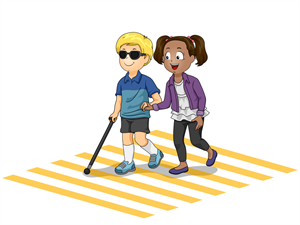
PUMPA - SMART LEARNING
எங்கள் ஆசிரியர்களுடன் 1-ஆன்-1 ஆலோசனை நேரத்தைப் பெறுங்கள். டாப்பர் ஆவதற்கு நாங்கள் பயிற்சி அளிப்போம்
Book Free DemoThe lesson "The Different Kind of School" is written by E. V. Lucas. It is a simplified version of the story "The School for Sympathy". There are three major characters in the lesson. They are:
1. The narrator
2. Miss Beam
3. A young girl
The story takes place in a school which is famous for its unique system. Miss Beam is the headmistress of the school. She believes that it is crucial to induce a sense of responsibility and kindness in the students. The main aim of the school is to make the students kinder human beings and responsible citizens.
The story begins with the narrator entering the school for the first time. When he entered, he found the school almost empty. Then he came across two students walking through the flower-beds. One of them was a girl. She was about \(12\) years old.
Interestingly, the girl's eyes were covered using a bandage. Since she had trouble seeing, she was guided by a boy of \(8\) years old. Sensing the narrator's presence, the girl enquired about him to her helper. She was curious because she couldn't see anything. The boy gave her a description of him. Then they walked on.

The girl with a bandage
The narrator moved on to meet Miss Beam. The narrator thought to himself that she possessed a look that could comfort a homesick child. She was a plump middle-aged woman whose hair had started to grey. She looked kind and commanding at the same time.

Miss Beam
Miss Beam greeted the narrator, and they began their conversation. The narrator asked her about the school and its unique system. According to Miss Beam, the school follows a simple curriculum. Basic mathematics such as addition, subtraction, division, and multiplication are taught. They are also trained to read and write. The teaching methodology is simple because the students will learn through interesting lectures and by reading.
Miss Beam greeted the narrator, and they began their conversation. The narrator asked her about the school and its unique system. According to Miss Beam, the school follows a simple curriculum. Basic mathematics such as addition, subtraction, division, and multiplication are taught. They are also trained to read and write. The teaching methodology is simple because the students will learn through interesting lectures and by reading.
However, what is unique and special about the school is that they have a set of five special days each term. The days are as follows:
1. Blind day
2. Lame day
3. Deaf day
4. Dumb day
5. Injured day
During the blind day, the students will cover their eyes completely. On that particular day, they would experience the life of a blind person. The eyes will be covered the previous night before the student goes to bed. The purpose is that the child should understand the problems of a blind person right from the beginning of the day. Hence, the girl who appeared at the beginning of the lesson was not blind. She was only on her blind day. The boy who was helping her was on his helping duty. Helpers are responsible for assisting the students in need.

Helpers assist the needy
During the lame day, the students will tie their legs up. They will have to walk using a crutch. This day was implemented to teach the students the difficulties faced by the people who cannot walk properly.
During the deaf day, the students are made to spend their day without being able to hear anything. Though this may seem easy, it can be quite challenging because you would have to live through a day without knowing what people are saying.
During the dumb day, the students are expected to be mute. The challenge here is that they will have to remain quiet by exercising their will-power. Unlike the blind day, their mouth will not be covered. While it is possible to cover your eyes or ears during the blind day and deaf day, it is not possible to do that your mouth. We need mouth to eat food, drink water, and also to breathe to an extent.
During the injured day, the students will tie their arms up through an arm sling. Again, this day teaches the students the discomfort faced by the people who have lost their arms or those who are injured.
Through this unique method of education, the school teaches the students the importance of empathy and kindness.
The narrator also meets another young student who is on her blind day. They talk about the different days and also shares her experiences being blind. She says that she had realised the pain and the discomfort faced by a blind person. The blind day gives her a headache because she is always in fear of getting hit by an object. She says that the inability to see anything scares her. In the girl's opinion, blind day is the worst, followed by the injured day. However, she considers the lame day funny and interesting because she could hop around on crutches.
The narrator and the girl take a walk. The narrator becomes her helper, and she asks him to describe the people around them to her. The narrator does so. He sees three people while walking, whom he describes to the girl. The people are:
1. Millie, the head girl
2. Peter, the gardener
3. Anita, a girl on crutches
After their conversation, the narrator goes back to meet Miss Beam. He finds that he has become more thoughtful than he had thought he could ever become. He says that he was feeling sad to leave the place.

The narrator became more thoughtful than before
The narrator’s statement shows that he became quite impressed with the unique system of the school. This makes Miss Beam happy because she exclaims by saying that she is pleased to know that her system is effective and that it works.